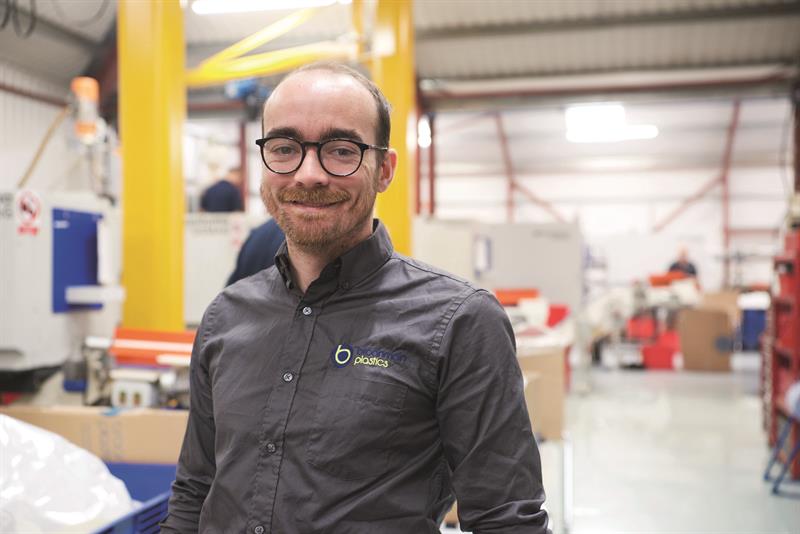So, how do you go about selecting the best, most sustainable plastic for your moulding venture today? With more than 85,000 listed plastic materials, and more than 45 polymer families, Thomas Catinat, production manager at Broanmain Plastics, explains some of the common compositions and characteristics of materials that start in pellet form and why, for the sake of ecology, we should learn to respect its purpose and consider innovative ways to upcycle, recycle and keep plastic out of the waste stream.
Back to basics
Plastics are essentially atoms that are grouped together to form molecules called monomers. These monomers link together to create polymers. That’s why ‘poly’ features in so many plastic materials names.
Polymers all offer varying degrees of strength, resistance, elasticity and even special features such as anti-bacterial or UV protection. The choice will depend on the application, for example if it needs to withstand high or extremely cold temperatures.
Narrowing the choices down can feel daunting. Although most customers know what they want, an experienced moulder can make recommendations based upon the environment the component is being used in, and help customers to consider other usability factors, such as slide action.
Mainstay materials
Polypropylene (PP) is generally deemed the most versatile and popular material for most applications. It has a fairly high melting point, can withstand daily wear and tear and is resistant to cracking and stress, even when flexed. For this reason, it’s often used in packaging applications, such as snap on lids, bottle caps, or medical tubing.
When replacing metal components with plastic, PP can be used to reduce weight providing the component won’t be put under a high level of stress. When high mechanical resistance is needed, a stronger polymer, such as nylon or a glass fibre filling might be used.
Another good feature of PP is, like other thermoplastics, it can be melted down to create new products. For example, car parts, storage boxes, plastic pallets and even garden furniture.
Acrylonitrile Butadiene Styrene (ABS) is also relatively inexpensive and has good impact and chemical resistance. For this reason, it is often used for visual parts, such as computer keyboard keys, televisions, plug sockets and even children’s play bricks.
Standard ABS is usually mixed with the most appropriate additives to make them cleaner, safer, stronger and shinier. Common examples include colour pigments, anti-static agents and heat stabilisers.
Polyamide nylon (the most common PA66) has a very good chemical resistance and can be used as another replacement for metal in applications that require high strength, toughness and weight reduction, for example automotive parts. However, it’s worth keeping in mind that nylon plastic can absorb moisture, which in softer polyamide products can affect the dimensional stability.

Polycarbonate (PC) was used to make the astronaut helmet for the Apollo landing in 1969. In everyday applications today, its low weight, impact resistance means that the material is used for parts that require clear lenses or windows, from car headlamps to visors, medical device cannulas and cell phones. PC is also used in a lot of safety gear used by professional sports athletes, such as the outer shell of ski helmets. Acrylic (PMMA) is an alternative, although the material is not as strong as PC.
Eco-options
With such a focus on sustainability and reducing plastic consumption, customers invariably ask about the moulding properties of bio-based materials. Although the cost of bio-based materials is gradually coming down, the price currently remains higher than fossil-derived polymers. There remain lots of developments in this field. And for many right now there are too many unknowns, including questions surrounding the true sustainability of harvested bio-based crops, such as corn.
For recycled plastics, the jury for many customers is also still out. Most prefer to source a pure polymer and don’t accept regrinds, as they are concerned that product performance will be compromised. From a scientific perspective, every time plastic is melted the molecular structure changes and degrades. Some call this a ‘heat history’. The more this happens, the weaker and more brittle the part gets. In time this can affect the characteristics of the end product, potentially compromising safety, hygiene or performance.
If using regrind it’s advisable to minimise the blend to 20% or less. Do remember that any subsequent pass through the machines will contain some of the previous regrind blend, so the ratio of regrind to virgin polymer will increase incrementally.
Mixing of the polymers in pellet or powder form is often performed by a material supplier, which a moulder buys in batches. However, most moulders, Broanmain included, have dosing units on site to create a polymer mix when smaller quantities are required.
It’s important to seek a moulding partner that can think creatively and use their engineering acumen and chemical knowledge to present the best materials for a moulding project. Understanding how the molecular structure of plastics change as they are processed is critical when considering which material to use for your project.











